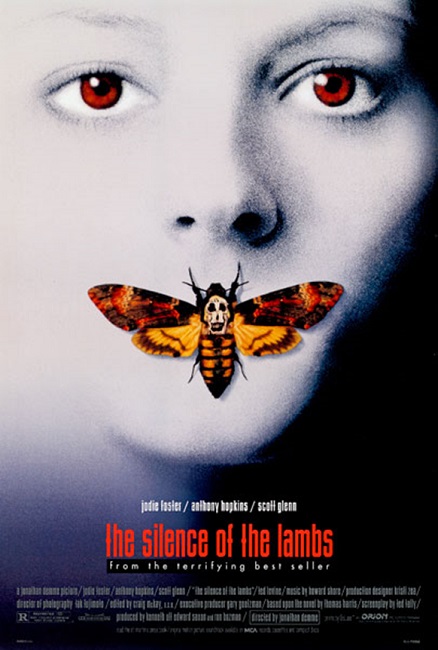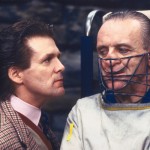
Silence of the Lambs – 1991
Oh My Goodness! This was an intense movie! My heart was beating fast at the end of the climax. My pulse was racing! Our two lead actors, Jody Foster and Anthony Hopkins both took home Best Actress and Best Actor awards. In addition, the director, Jonathan Demme, and screenplay adaptor, Ted Tally, won Oscars, making the Silence of the Lambs the third film in Academy Award history to win “the big five.” The other two were It Happened One Night in 1934 and One Flew Over the Cuckoo’s Nest in 1975.
Foster and Hopkins were both brilliant in this movie. Their performances were so intense and… merciless. They never let up, never backed down, and never held back. Foster is the kind of actress that typically throws her entire being into whatever role she is doing. She is not afraid of getting physical and personal. Hopkins created an iconic character that actually popularized the psychotic serial cannibal, causing Hollywood to spawn more movies about him.
Foster plays FBI trainee Clarice Starling, a young woman who pushes herself to unbelievable limits to prove that she can handle anything. She is in the top quarter of her class at the FBI Training Academy at Quantico, but she is called in to the office of Jack Crawford, played by Scott Glenn. He is a part of the Bureau’s Behavioral Sciences Unit. He enlists her help in interviewing a prisoner in maximum security lock-up for the criminally insane.
The man she is to interview is Dr. Hannibal Lecter, played by Hopkins. His nickname is Hannibal the Cannibal because he is known for eating his victims. But aside from being this monster, he is also a brilliant man with a mind as sharp as a blade. Crawford believes Lecter can offer insight on helping to catch a serial killer knows as Buffalo Bill.
The famous first interview scene in which Clarice questions Lecter is actually pretty early on in the film. The Director used a lot of extreme close-up shots, putting everything right in the face of the audience. You are able to focus on the actor’s eyes and feel the full intensity of their gazes. Their back-and–forth conversation is quick and unnerving. Clarice is obviously being affected and is struggling to hold her composure. Lecter is relentless as he drills into her psyche, forcing her to lay the painful secrets of her life before him. It is no surprise that after she leaves the cell block, she is in tears. But in return, he has given her essential insights into the Buffalo Bill case.
Interesting note: Hopkins won the Best Actor Academy Award, though he only had a little over 16 minutes of screen-time.
Now, here I have to mention two other actors who did their jobs well. First there is Anthony Heald who played the part of Frederick Chilton. This is the character you are really not supposed to like, and Heald really played it perfectly. He was smarmy, arrogant, chauvinistic, mean, and just an all-around asshole. He was Lecter’s jailer at the facility for the criminally insane, but he was such an idiot that he enjoyed torturing the inmates in subtle ways, making fun of them to their faces and treating them like caged animals. This makes the end of the movie especially satisfying, but we’ll get to that in a bit.
Next was Ted Levine, playing the part of Buffalo Bill. OK, now this guy really played his part well. He was the biggest creepy element of the film. He was a serial killer whose particular kind of criminal psychosis was hard to define. According to the director he was a man who hated himself so much that he had a desire to change himself as much as possible. The most effective way he could do that was to become a woman. However, the sex change clinics would not perform the operation for him because he was too unstable. His solution was to abduct overweight women and remove their skins to make a “woman suit.”
“It puts the lotion on its skin or it gets the hose again.” We have all heard that famous line from time to time, usually followed by a brief but awkward chuckle. But when put in the context of the film, it is a chilling statement. He would put his victims in a deep well to prevent escape, starve them for three days to loosen their skin, and eventually kill them to remove their skin. It is a horrible and disturbing concept, made even more terrifying because we know that there are actually people like that in the world.
Levine was wonderful in the role. It was the way he talked, the way he moved, the way he was calm one minute and enraged the next. The character was beyond unstable and was absolutely unsettling to watch, which was exactly what he was supposed to be. When he forcibly abducted the main victim of the film, a character named Catherine Martin, played by Brooke Smith, his moans of pleasure as he looked at the skin of her back almost sounded sexual in nature, though going by the director’s explanation of his character’s motivations, it was really not. But the sick excitement he derived from his actions was part of what made his character so disturbing.
Interesting note: When it came to casting, we very nearly had a quite different movie. Originally, Gene Hackman was supposed to play the part of Hannibal Lecter. He withdrew from the project when the evolving screenplay started to become too graphic. Michelle Pfeifer was the first person offered the role of Clarice Starling, but turned it down because she was uncomfortable with the subject matter.
The music and sets were all pretty much as you might expect. Howard Shore wrote a score that was appropriately dark and suspenseful, enhancing the unnerving content of the film. One of the best parts of the movie, and one of the creepiest, is the scene in which Clarice accidentally stumbles on to Buffalo Bill and follows him into his labyrinthine basement. She finds the abducted girl who is screaming in terror to be let out of the well.
Trainee Starling has her gun drawn and is searching the basement for the killer. She sees some of the most disgusting and horrifying sights she has ever seen. But then the lights go out and she is left in absolute darkness. Buffalo Bill has put on a pair of night-vision goggles and can see her just fine. Foster was particularly fantastic in this scene. The intensity of her performance doesn’t let up for a moment. As she is feeling her way along the walls, we see her through Bill’s goggles. At several points, we see his hand enter the picture as the reaches for her, almost touching her several times, and she obviously has no idea how close to her Bill actually is. Oh my God! My heart was racing! Great film making!
As I mentioned earlier, the film had a very satisfying ending. In order to explain that, I have to give away a little more of the plot. At one point, in a particularly horrifying sequence, Lecter manages to escape from prison, mercilessly slaughtering several people. And while I am on that subject, I have to say that I thought this a little unrealistic. In the real world they would not have just two morons guarding a maximum security level, criminally insane genius. Nor would they ever have him in any kind of public building which might give him any kind of opportunity for escape. They just wouldn’t.
But never-mind that.
OK, so Lecter frees himself and disappears into the world. He is gone, never to be seen again… or is he? In the penultimate scene as Clarice is graduating from the Academy, and is now a full-fledged special agent for the FBI, she receives a phone call that takes her away from the party. She picks up the phone and hears Lecter’s voice. The look of terror that washes over her face was incredibly realistic. Lecter speaks to her as if she is an old friend, saying, “I have no plans to call on you, Clarice. The world’s more interesting with you in it.” He also tells her that he is meeting an old friend for dinner.
However, as he hangs up the phone, leaving Clarice cowering in fear by the phone, the scene changes to show Hannibal the Cannibal in a wig, sunglasses and hat. He is watching Dr. Chilton disembark from a plane in what looks like a foreign country. It is obvious that he means to murder and eat Chilton.
Now, while we, as the audience, know that it is sick and twisted, we also have to own-up to the fact that we secretly want it to happen. By this time we have come to respect the dangerousness of the genius, Dr. Lecter (doctor because he used to be a psychiatrist before becoming a serial killer) and learned to dislike the character of Chilton for a number of reasons. As Lecter follows his intended victim into the distance, the credits start to roll and we breathe a sigh of relief that the movie has reached its unnerving conclusion. I stood up and had to do a little pacing to shake off that horrified feeling. Very effective story telling!
Interesting note: Silence of the Lambs was the first and only Best Picture winner that has been categorized as a thriller/horror movie. Most films are listed as dramas with a number of musicals thrown into the mix. The only exception to this might be Alfred Hitchcock’s Rebecca in 1940, though I might call that one a mystery.








